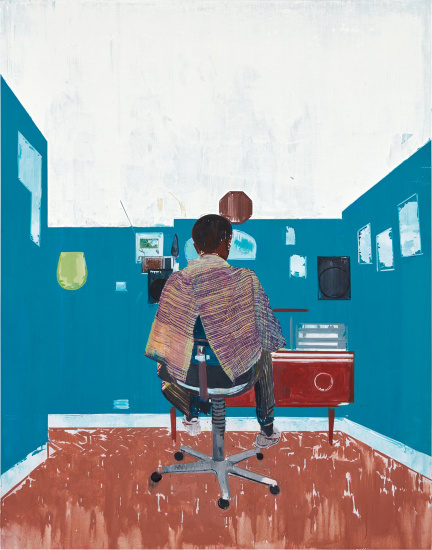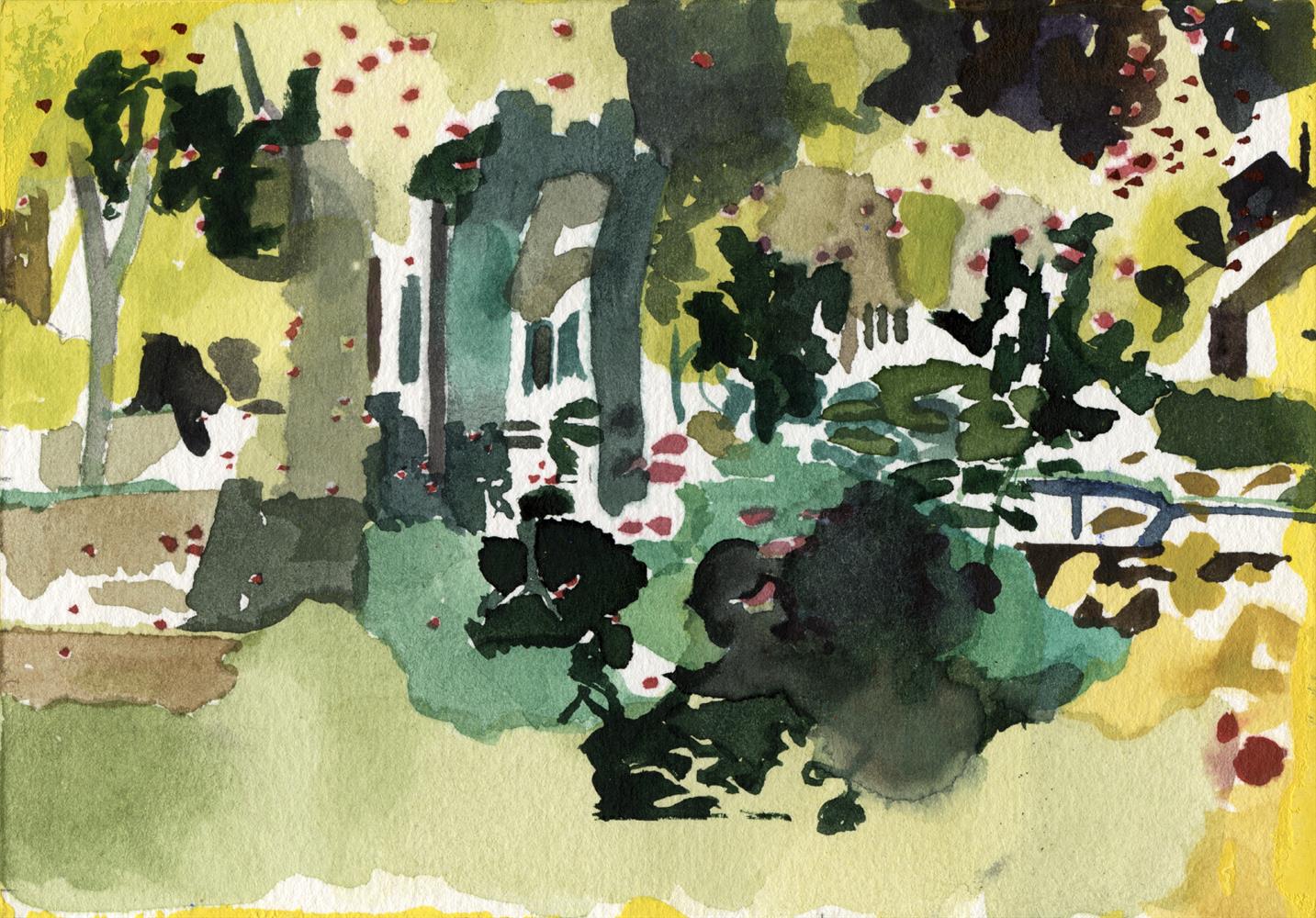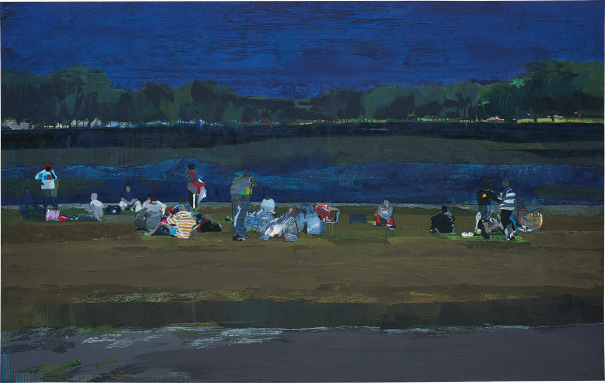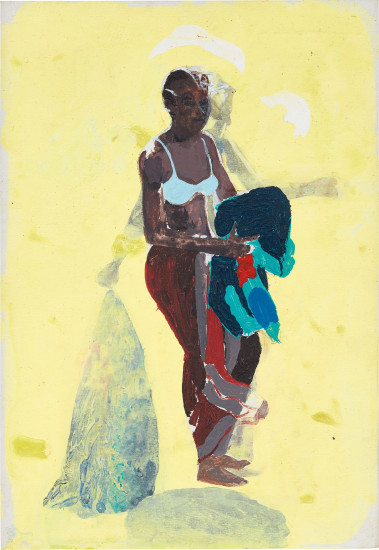Ο27Hurvin AndersonMarlene’ssigned with the artist's initials, titled and dated '''Marlene's'' April 2005 H.A' on the overlap; further titled 'Marlene's' on the stretcher oil on canvas 88.4 x 146 cm (34 3/4 x 57 1/2 in.) Painted in April 2005. Full CataloguingEstimate £250,000 - 350,000 ‡ ♠ Place Advance BidContact Specialist Kate Bryan Specialist, Head of Evening Sale +44 20 7318 4026 kbryan@phillips.com
Overview'The architecture of Trinidad and in particular the detail of the security grills became part of my painterly language and they became a symbol of how I understood what was happening there.' —Hurvin Anderson Hurvin Anderson’s Marlene’s is a fascinating study into the painterly genre. Straddling figuration and abstraction, the composition presents six distinct pictorial planes, crosshatched and dotted with areas of colour, separated by thick white bands emulating the rhythmic formulaism of a window’s muntin bars. While a simple glance will only grant the viewer a slim idea of the scene at play, careful inspection will reveal the timid outlines of objects drenched in vibrant colour – ultimately identifying the painting’s setting as the interior of a bar. Exhibited at the Hurvin Anderson New Paintings exhibition at Thomas Dane in 2005, Marlene’s was accompanied by a group of works on paper as well as five paintings on canvas which were broadly classified under two themes: the tradition of landscape painting and the visual element of the grid. Though Anderson works from pre-existing photographs, the artist frequently drifts from a given image’s specific characteristics, and weaves personal impressions and recollections to compose an entirely new -- yet eerily evocative -- image. ‘[Anderson’s] source material is simply a starting point’, writes Jennifer Higgie; ‘it’s equally important for him to allow the experiences and locations referenced in his pictures to collide and interact’.i In Marlene’s, it seems that Anderson indeed utilises his subject matter as a platform from which to revisit abstract principles, as well as a symbolic ground from which to tackle political issues relating to colonialism – specifically in the Carribean, where the scene is set. Playing on Marlene’s’ different layers, both compositionally and thematically, Anderson seamlessly pairs art historical tradition with contemporary critique. 'I began to use the security grill as a motif or device and eventually as a structure in the paintings. They became a useful vehicle to describe something about the place. The grills suggested a kind of “blot” on the landscape, that something wasn’t quite right.' —Hurvin AndersonForming part of a group of paintings composing the Welcome series, Marlene’s is structured around the dizzying visual component of the grid – herein embodied by a wire security grille guarding the presumably eponymous West Indian establishment. Swiftly shifting to abstraction as horizontal, diagonal and vertical lines form a monochromatic mesh, the composition veers between a simple reading of the surface and the physical possibility of depth, as if perpetually moving in and out of focus. ‘All of Hurvin’s work seems to me to incorporate an intense amount of depth’ writes Thelma Golden, director of The Studio Museum, Harlem, at the time of the artist’s show there. ‘Depth of field, depth of colour, and even depth of subject’.ii Enabling the conflation of multiple layers, enabled by a spatial interplay between the diamond-shaped lattice, the sweeping perspectival lines of the ceiling and the windows’ thick muntin bars, Anderson’s wire grille calls to mind a number of modern art historical antecedents focusing on compositional structure. The gridded pattern – a notorious minimalist tool and visual element – notably echoes Piet Mondrian’s corpus of geometric canvases interspersed with colour, specifically Trafalgar Square, 1939-43, residing at the Museum of Modern Art, New York. Much like Marlene’s focuses on the formal aspect of the composition rather than attending to the precise characteristics of the represented bar, Trafalgar Square possesses an explicit titular reference that nonetheless remains invisible to the naked eye. Wojciech Fangor M 22, 1968, oil on canvas, The Israel Museum, Jerusalem Image: Bridgeman Images. Reproduced with permission of The Fangor Estate. Wojciech Fangor E 22, 1965, oil on canvas, Museum Sztuki, Łódź. Image: Muz
Ο27Hurvin AndersonMarlene’ssigned with the artist's initials, titled and dated '''Marlene's'' April 2005 H.A' on the overlap; further titled 'Marlene's' on the stretcher oil on canvas 88.4 x 146 cm (34 3/4 x 57 1/2 in.) Painted in April 2005. Full CataloguingEstimate £250,000 - 350,000 ‡ ♠ Place Advance BidContact Specialist Kate Bryan Specialist, Head of Evening Sale +44 20 7318 4026 kbryan@phillips.com
Overview'The architecture of Trinidad and in particular the detail of the security grills became part of my painterly language and they became a symbol of how I understood what was happening there.' —Hurvin Anderson Hurvin Anderson’s Marlene’s is a fascinating study into the painterly genre. Straddling figuration and abstraction, the composition presents six distinct pictorial planes, crosshatched and dotted with areas of colour, separated by thick white bands emulating the rhythmic formulaism of a window’s muntin bars. While a simple glance will only grant the viewer a slim idea of the scene at play, careful inspection will reveal the timid outlines of objects drenched in vibrant colour – ultimately identifying the painting’s setting as the interior of a bar. Exhibited at the Hurvin Anderson New Paintings exhibition at Thomas Dane in 2005, Marlene’s was accompanied by a group of works on paper as well as five paintings on canvas which were broadly classified under two themes: the tradition of landscape painting and the visual element of the grid. Though Anderson works from pre-existing photographs, the artist frequently drifts from a given image’s specific characteristics, and weaves personal impressions and recollections to compose an entirely new -- yet eerily evocative -- image. ‘[Anderson’s] source material is simply a starting point’, writes Jennifer Higgie; ‘it’s equally important for him to allow the experiences and locations referenced in his pictures to collide and interact’.i In Marlene’s, it seems that Anderson indeed utilises his subject matter as a platform from which to revisit abstract principles, as well as a symbolic ground from which to tackle political issues relating to colonialism – specifically in the Carribean, where the scene is set. Playing on Marlene’s’ different layers, both compositionally and thematically, Anderson seamlessly pairs art historical tradition with contemporary critique. 'I began to use the security grill as a motif or device and eventually as a structure in the paintings. They became a useful vehicle to describe something about the place. The grills suggested a kind of “blot” on the landscape, that something wasn’t quite right.' —Hurvin AndersonForming part of a group of paintings composing the Welcome series, Marlene’s is structured around the dizzying visual component of the grid – herein embodied by a wire security grille guarding the presumably eponymous West Indian establishment. Swiftly shifting to abstraction as horizontal, diagonal and vertical lines form a monochromatic mesh, the composition veers between a simple reading of the surface and the physical possibility of depth, as if perpetually moving in and out of focus. ‘All of Hurvin’s work seems to me to incorporate an intense amount of depth’ writes Thelma Golden, director of The Studio Museum, Harlem, at the time of the artist’s show there. ‘Depth of field, depth of colour, and even depth of subject’.ii Enabling the conflation of multiple layers, enabled by a spatial interplay between the diamond-shaped lattice, the sweeping perspectival lines of the ceiling and the windows’ thick muntin bars, Anderson’s wire grille calls to mind a number of modern art historical antecedents focusing on compositional structure. The gridded pattern – a notorious minimalist tool and visual element – notably echoes Piet Mondrian’s corpus of geometric canvases interspersed with colour, specifically Trafalgar Square, 1939-43, residing at the Museum of Modern Art, New York. Much like Marlene’s focuses on the formal aspect of the composition rather than attending to the precise characteristics of the represented bar, Trafalgar Square possesses an explicit titular reference that nonetheless remains invisible to the naked eye. Wojciech Fangor M 22, 1968, oil on canvas, The Israel Museum, Jerusalem Image: Bridgeman Images. Reproduced with permission of The Fangor Estate. Wojciech Fangor E 22, 1965, oil on canvas, Museum Sztuki, Łódź. Image: Muz





.jpg)
.jpg)
.jpg)


.jpg)



.jpg)
Testen Sie LotSearch und seine Premium-Features 7 Tage - ohne Kosten!
Lassen Sie sich automatisch über neue Objekte in kommenden Auktionen benachrichtigen.
Suchauftrag anlegen